Organ-on-chip project receives huge grant to make the leap from lab to fab
NWO Perspective grant of 4.8 million euros for multidisciplinary consortium, led by TU/e professor Jaap den Toonder to develop much-needed universal standard for the pharmaceutical industry.
Prof. Pamela Habibovic en prof. Roman Truckenmüller of MERLN Institute participate in this project.
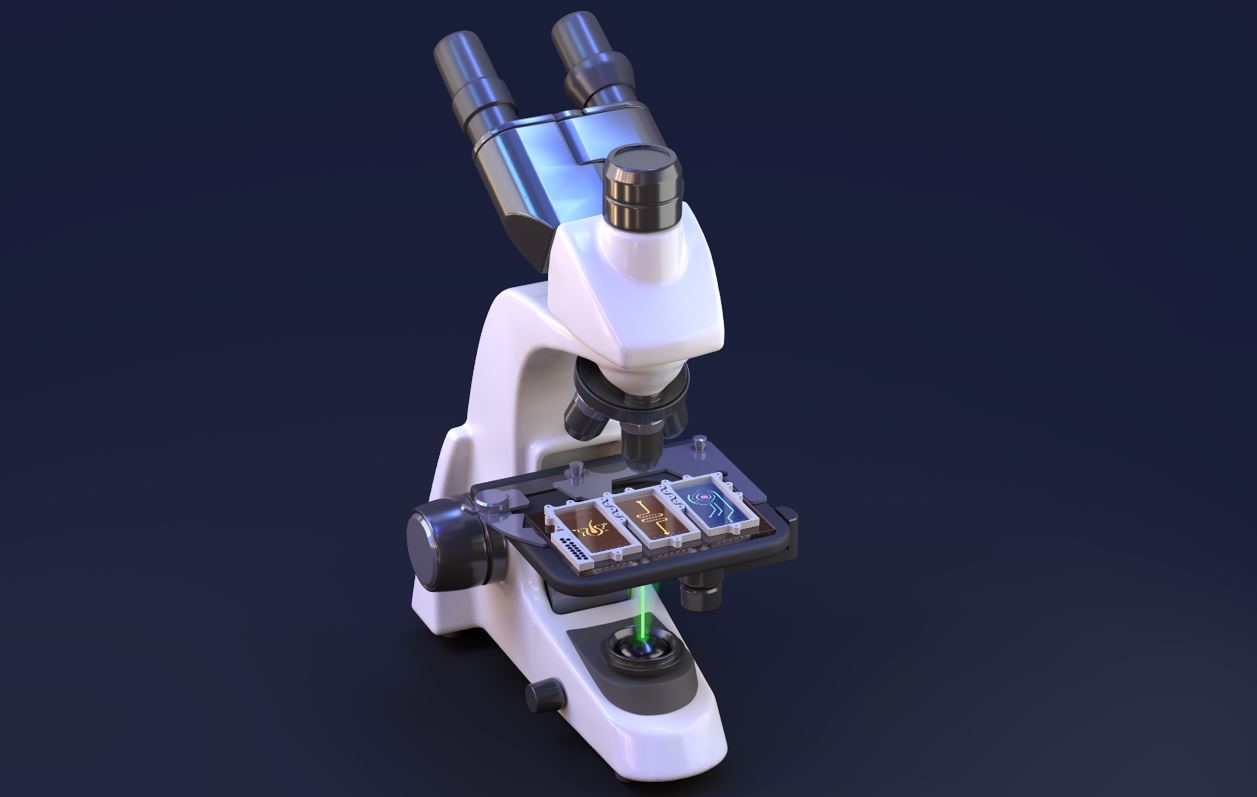
Scientists are pushing ahead building ‘organ-on-chips’, small chips with human cells, which are useful, for example, for studying cancerous metastases in the bloodstream or the development of scar tissue, or for testing the effect of drugs or food outside a human body. To make the step to industry, a collective of dozens of research groups, companies and knowledge institutions, brought together by the organ-on-chip consortium hDMT, are building a universal standard, supported by a NWO Perspective grant of nearly five million euros. The ultimate goal in the future: to link multiple organ chips together to simulate a whole body.
Those who think of chips only in terms of computers are nowadays deceived. An organ-on-chip usually consists of a plastic plate with integrated microchannels and chambers. Inside grow the complex tissues of human cells, in an environment that mimics the human body, but is barely visible to the naked eye.
A minute amount of liquid flows along the living cells to supply them with nutrients, and a pump delivers and removes them. Sensors in the chip measure how the cells respond and actuators make changes. For example, a different pressure, mechanical force, oxygen level or flow velocity.
By then adding a drug, food or cosmetic product to be tested, the researchers can see how the tissues react. The chip fits perfectly under a light microscope, so that the process can be followed easily and live.
Scaling up stalled by lack of universal standard
At the moment, the chips are mainly used by researchers to better understand how cells behave in their micro-environment or how diseases develop and spread through the body. In Eindhoven, for example, they are working on cancer-on-chip (see the video below) and nervous system-on-chip.
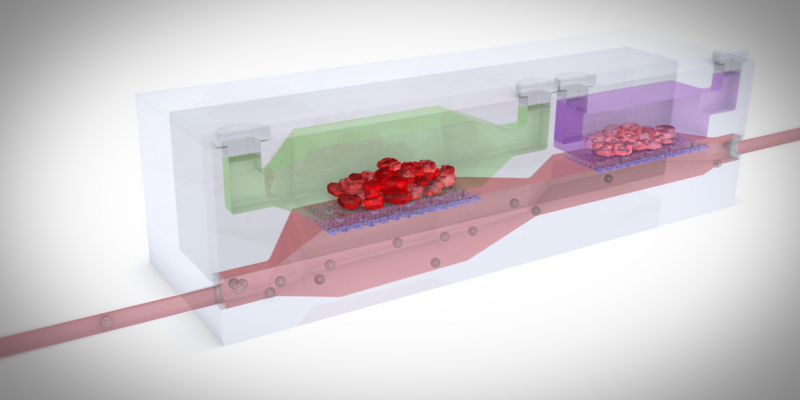
This video shows how cancer cells from the first organ spread out through the bloodstream, and then nestle and multiply in the second organ. Through this organ-on-chip application, researchers can closely monitor what is happening in order to better understand the process of cancer metastasis. Animation: ICMS Animation Studio.
However, large-scale use by the pharma is not yet on the agenda due to the lack of a universal standard. There are many kinds of chips, each with its own design, dimensions and material. Moreover, the chips are difficult to fit into the workflow of the pharmaceutical industry and scaling up to larger numbers is very difficult. In short, they are designed for research, not for industry.
This is what the 10 research groups of 8 universities, united in the Dutch ‘organ-on-chip’ consortium hDMT, want to change, together with 21 companies, 3 knowledge institutions and 2 foundations. Led by researcher Jaap den Toonder of TU Eindhoven, they are now going to develop a standardized and modular platform for organs-on-chips, the 'SMART Organ-on-Chip'. On March 10, they were awarded the NWO 'Perspective' grant of 3.4 million euros. The industrial partners are investing another 1.4 million euros in the project.
Harmful drugs can be eliminated earlier
Pharmaceutical companies have a lot to gain from the standardized platform. Developing a new drug takes at least 10 years and billions of euros. This lengthy and expensive process is due to the different phases that the new drug has to go through. And 80% of promising drugs still drop out in the final phase.
Den Toonder: “If you can test the drugs directly on a realistic human organ-on-chip model, incorporating the complexity of the body right away, then you can eliminate harmful or ineffective drugs much earlier in the process, thereby saving a lot of money.”
Connecting Chips
To standardize the chips, the researchers are building a standard-sized "docking" plate that accommodates the fluid channels and electronics. Then the chips can be clicked onto it like modules.
The researchers develop tissue chips in which the cells are in the right microenvironment and technical chips with innovative fluid pumps and physical and chemical sensors. Den Toonder: "That's what makes the system so flexible; you can click the chips onto it in any combination you want, depending on the type of organ you want to examine and the question you want to answer."
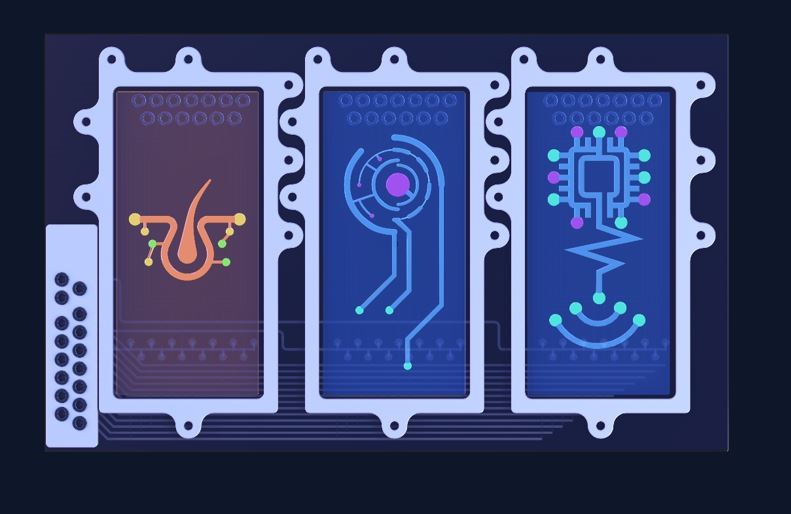
A visual representation of one tissue chip of skin and hair and two technical chips, which are precisely clicked onto the 'docking' plate and to each other. Picture: hDMT
The whole system is aligned with industrial workflows and biomedical R&D, for example, to work with pipetting robots and complex microscopic techniques. Moreover, it will be an accessible open technology, so that other companies can develop their own applications and add them to the existing platform.
Den Toonder: "By linking the various organ-on-chip models, we can ultimately also simulate the interactions between organs. That is really important, because organs never function in a body on their own. We hope that in time we will be able to develop, link and study chips for all the organs in the human body. Our ultimate dream is therefore a 'body-on-chip', with which you can study the effect of a new drug in all the organs, for example, so that you can simultaneously see whether the liver is not breaking down the drug, whether the intestines are not damaged, and whether heart problems develop.”
Studying scars
In the Perspective program, the researchers are focusing in particular on the development of scar tissue: fibrosis. Besides nicely healed scars, fibrosis of organs sometimes progresses into proliferating connective tissue. The area around the organ then plays a major role. It is therefore crucial to include that environment when studying this process in organ-on-chip models.
It is precisely this complexity that has so far prevented a good model for studying fibrosis. The team is therefore now building tissue chips from intestines, skin and joints to study the processes at the system level.
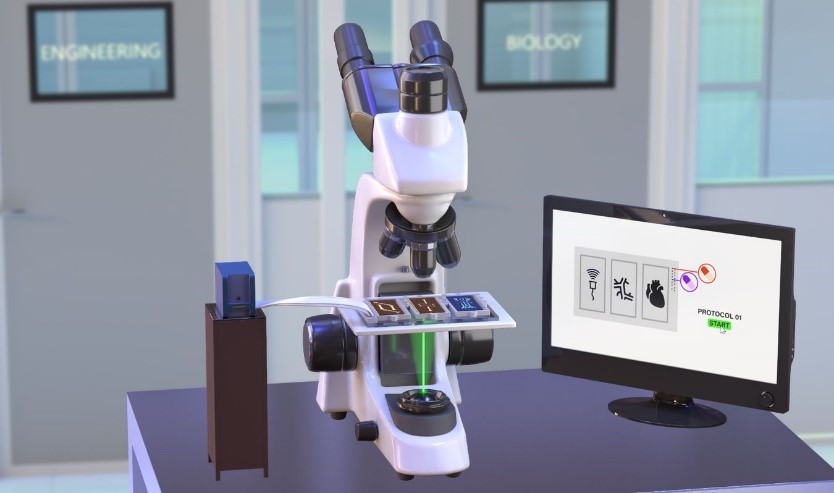
A visual representation of the universal standard in practice. The docking plate, containing three chips, fits exactly under a simple microscope. The various sensors and actuators are controlled via the computer. Picture: hDMT
Den Toonder: "The NWO Perspective grant gives us the opportunity to bring together the broad multidisciplinary group of scientists you need for such a development with industrial partners, from manufacturing to end users." Den Toonder is a mechanical engineer within the Institute for Complex Molecular Systems (ICMS) at TU Eindhoven.
The right drug for that one patient
In addition to the pharmaceutical industry, the emerging research field of personalized medicine can also benefit greatly from standardized organ-on-chip technology. Drugs are now developed for the average person, and only work for one in four people if you are lucky. There are even drugs on the market that only work for one in twenty people. If you can pre-screen a few potential drugs on cells from the specific patient for whom you are seeking treatment, you can administer the right drug for that specific person immediately.
The new chips are also finding industrial applications outside of pharma. For example, a skin-on-chip to test the side-effects of cosmetics or an intestine-on-chip to test allergies to a new food product. A bonus of organ-on-chip technology will be a considerable reduction in the number of animal tests.
The Dutch organ-on-chip consortium hDMT brought the following partners together for this NWO Perspective program: Amsterdam UMC/VUmc, Delft University of Technology, Eindhoven University of Technology, UMC Utrecht, Leiden University, Maastricht University, Twente University, Wageningen University & Research, 300MICRONS, Applikon, BioLamina, Convergence, Demcon, dsRAT Stichting Proefdiervrij, Galapagos, Genmab, Hy2Care, IBA Lifesciences, ibidi, Life Science Methods, LipoCoat, Micronit Microtechnologies, OnePlanet Research Center/imec, Poietis, PolyVation, provio, Qurin Diagnostics, ReumaNederland, RIVM, Spektrax, TissUse, TNO, Unilever Safety & Environmental Assurance Centre, Ushio INC.
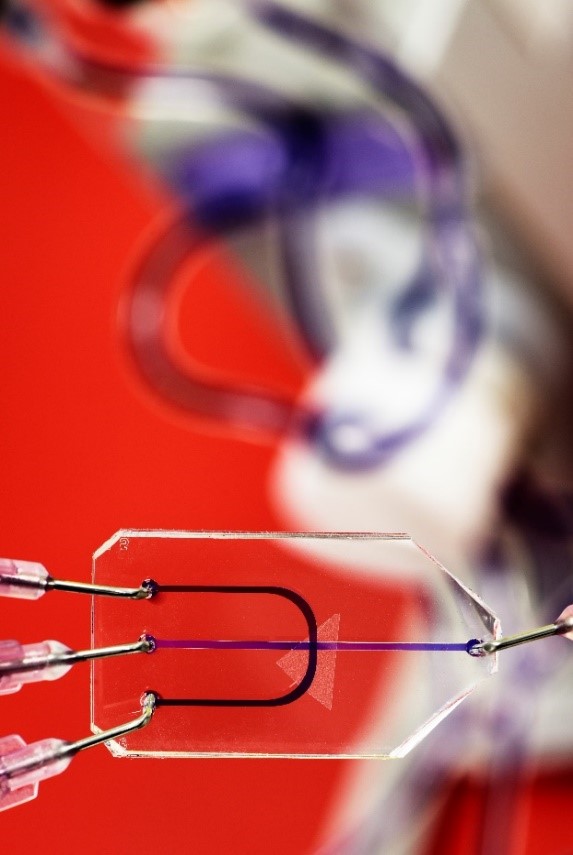
An example of an organ-on-chip, a plate with integrated microchannels in which complex tissues of living cells can be studied. Photo: Bart van Overbeeke, TU Eindhoven.
For more information on this MERLN research expertise, contact Dennie Hebels.